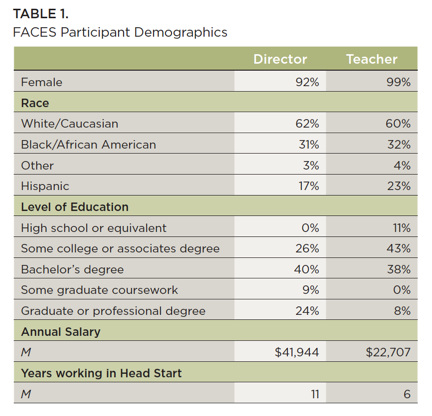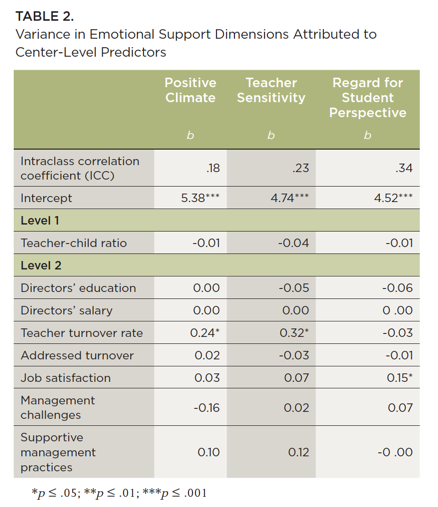This document may be printed, photocopied, and disseminated freely with attribution. All content is the property of the McCormick Center for Early Childhood Leadership.
This resource is part of our Research Notes series.
Research suggests that emotional support improves children’s academic and social development. Children in classrooms characterized by emotionally supportive teachers and environments are less likely to exhibit problem behaviors, negative affect, and aggression.
Research also suggests the organizational climate of early childhood programs affects overall program quality. A recent study by Katherine Zinsser and Timothy Curby examined early childhood centers to determine if various center characteristics could predict teachers’ emotional support of children in their classrooms.1
The researchers used the Head Start Family and Child Experiences Survey (FACES) 2009 dataset to analyze 370 classrooms from 120 centers.2 The directors were interviewed about program characteristics, management practices, and their personal experiences and satisfaction in the workplace. They also reported about their job satisfaction by answering a questionnaire. Table 1 summarizes characteristics of directors and teachers in the FACES study.

The Classroom Assessment Scoring System (CLASS) was used to examine four dimensions of emotional support among teachers and children: Positive climate, negative climate, teacher sensitivity, and regard for student perspectives.3
Hierarchical Linear Modeling (HLM) was the method used to analyze the relationship among factors at the classroom and centerwide levels that were related to the four Emotional Support Dimensions CLASS scores. One factor at the classroom level (teacher-child ratio) and 7 factors at the center-wide level (directors’ level of education, directors’ salary, teacher turnover rate in the past year, steps to address turnover, directors’ job satisfaction, management challenges, and supportive management practices) were incorporated in the model.
The analysis of the overall model showed there were significant differences for three of the four Dimensions of Emotional Support by calculating an intra-class correlation coefficient (ICC): positive climate (ICC = .18), teacher sensitivity (ICC = .23), and regard for student perspectives (ICC = .34). Significant ICC values explain the amount of variance in emotional support that can be attributed to center characteristics. Thus the amount of variance in CLASS scores attributed to center-level characteristics was 18% for positive climate, 23% for teacher sensitivity, and 34% for regard for student perspectives. Significant differences were not found for the dimension of negative climate suggesting this dimension could be affected more by classroom characteristics than from those of the overall center
Surprisingly, teacher turnover positively predicted emotional support in the dimensions of positive climate (b = 0.24, p < .05) and teacher sensitivity (b = 0.32, p < .05). Directors’ job satisfaction was found to significantly predict regard for student perspectives (b = 0.15, p < .05). Table 2 shows the variance found in the emotional support dimensions as predicted by center-level characteristics.

There is substantial evidence that teacher-child interactions impact children’s development and learning.4 We also know organizational climate influences teaching practice.5 This study highlights these relationships and teases out some important dimensional relationships. While these findings do not demonstrate a causal link from teacher turnover and directors’ job satisfaction to child outcomes, they do provide evidence of the impact of workplace climate on both teacher dispositions and classroom environments.
While the disruption caused by teacher turnover is typically regarded as a negative indicator of program quality, these findings suggest there may be some positive effects when teachers leave. The authors suppose this could result from underperforming teachers who are counseled out or terminated from their programs, newly hired teachers could be better educated, or incoming teachers may be trained to better support the social and emotional development of children.
The relationship between directors’ job satisfaction and positive regard for students’ perspectives is also an important finding from this study. It is important to note that this finding does not confirm the direction of the relationship—whether directors who are satisfied on the job influence teachers to adopt a child-focused approach or whether teachers’ regard for student autonomy contributes to the workplace environment, thus affecting directors’ job satisfaction.
Regard for student perspectives is an essential dimension of emotional support concerned with teacher-child interactions that focus on children’s interests, motivations, and points of view.6 The CLASS assesses the degree to which teachers are flexible in their plans; accept children’s ideas and organize learning activities around their interests; support children’s autonomy and leadership; and provide children with opportunity for expression and freedom to move around. It is reasonable to expect that a director with strong self-efficacy beliefs and contentment about the workplace would allow for this kind of classroom climate. This research indicates there is a relationship between directors’ satisfaction at work and the emotional support teachers provide to children.
Zinsser and Curby suggest that factors like enjoying work, belief that one is making a difference, and commitment to early childhood education are the kind of dimensions that contribute to director’s job satisfaction. Directors who are reflective practitioners and think positively about their personal leadership and the effectiveness of their program are likely to have a high regard for their work and workplace. Overly-controlling directors and administrators contribute to an organizational climate that translates to rigid and narrowly defined teaching practices.